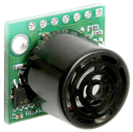Sensors
Under Construction - information liable to change.
|
|
Mapping A terrain map must be produced to communicate the locations of each victim found. This is partly achieved using a laser scanner, which has the advantage of being unaffected by acoustic tiles (these are made from sound absorbing foam and cause problems for sonar rangers). Hokuyo URG-04LX (240 degree range) |
|
|
Thermal Imaging Identifying thermal signs of life is essential. In the competition, heat is radiated through heat pads dispensed under a victims clothing. The temperature of the victims is approximately 37°C (±2°). 16x16 array via RS232 |
|
|
Machine Vision Two Fire-I Digital cameras provide the operator’s ‘eyes, aiding manual control. Additionally post-processing techniques can be implemented to assist victim identification. The cameras are aided by LEDs for low light navigation. 30 fps, 640x480 resolution Firewire connection |
 |
Audio Detection A microphone will be used to detect victim noise, ranging from 55-100dB. Efficiency testing is underway with a unidirectional microphone. If simulated victim cries are not efficiently detected, directional microphones and arrays may also be considered. |
 |
Carbon Dioxide Detection RoboRescue victims can be detected by a buildup of CO2 of greater than 2000 parts per million. Standard off the shelf CO2 sensors are available that produce a voltage proportional to the concentration of CO2. |
 |
Sonar Rangefinders The robot houses six sonar rangefinders, to aid collision prevention with stationary objects, such as walls. Five MaxSonar EZ3 and wider range, EZ0 will be used. An EZ3 on each corner provides close proximity detection. An EZ3 and EZ0 placed on the robot arm enables alignment with victim enclosures. |



